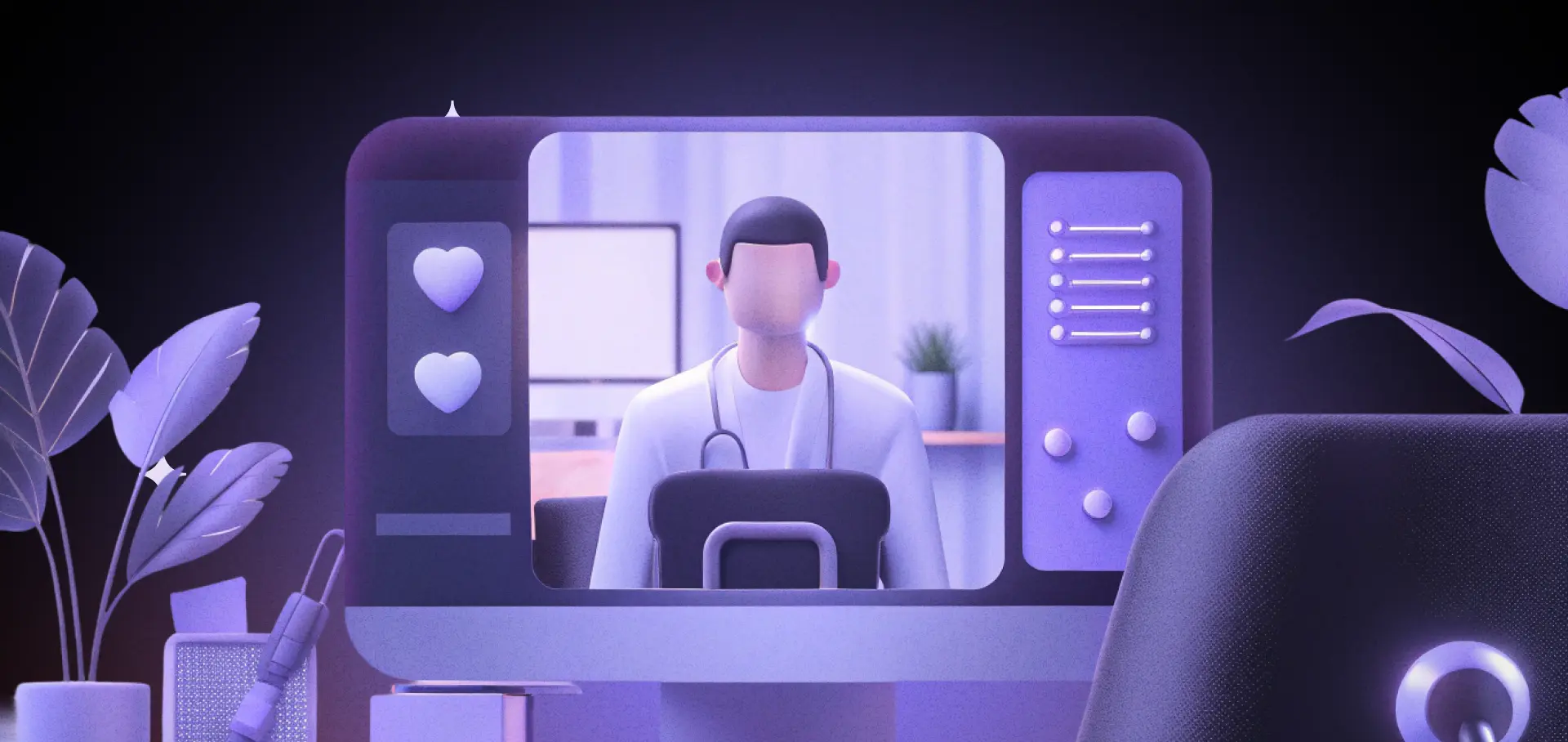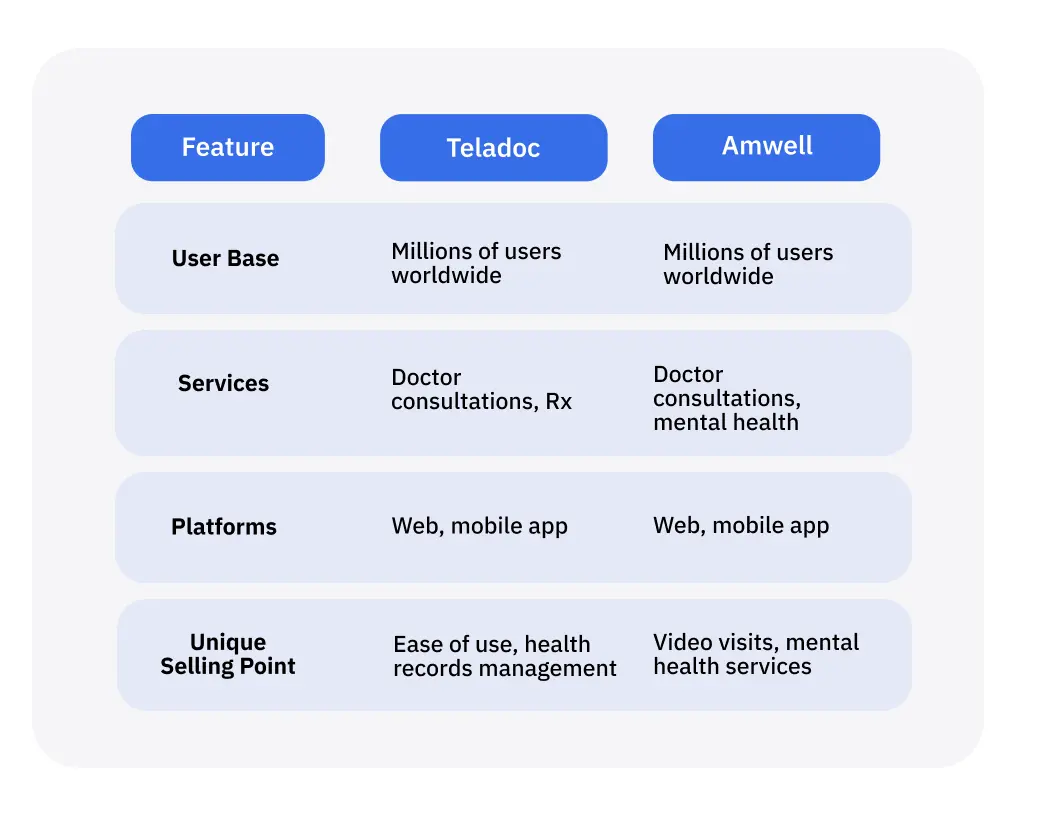
The healthcare industry is undergoing rapid change, with telehealth software development at the forefront. Market numbers tell an exciting story: a 37.8% growth expected between 2021 and 2028. This boom comes from real needs as our population ages and more people manage long-term health conditions.
Building these platforms takes careful planning though. Success comes from focusing on what users really need, starting with basic features, and testing ideas before going all-in. The process usually takes between 1 to 6 months, depending on what you want to build. The key is selecting the right development team and incorporating must-have features, such as secure video calls and HIPAA-compliant data protection. This article will guide you through the process of creating a telehealth platform, from initial planning to final launch.
Why Trust Our Telehealth Development Expertise?
At Fora Soft, we've been at the forefront of multimedia and telehealth software development since 2005, accumulating over 20 years of hands-on experience in creating secure, scalable video streaming solutions. Our specialized focus on telemedicine and video streaming technology has led to a 100% project success rating on Upwork. This laser-focused expertise means we have an intimate understanding of the unique challenges and requirements of telehealth platform development.
Our team has implemented numerous successful telehealth solutions, including custom platforms that utilize WebRTC, LiveKit, and other cutting-edge technologies, ensuring HIPAA compliance and seamless video consultations. We've developed cross-platform solutions that work across web, iOS, Android, and smart devices, ensuring accessibility for both healthcare providers and patients. Our experience with AI integration in video streaming adds another layer of sophistication to our telehealth solutions, enabling features like automated patient monitoring and intelligent scheduling systems.
What Is Telehealth Software Development and Why It Matters

Telehealth software development involves creating digital tools that enable remote connections between patients and healthcare providers. This market is experiencing rapid growth, with companies such as Teladoc and Amwell leading the way.
However, developing these tools isn't always easy; many projects face common pitfalls.
Current Market Opportunities and Growth Potential
As you look to expand your product offerings, consider this: the demand for telehealth software is surging. The global telehealth market is projected to grow at a CAGR of 37.8% from 2021 to 2028, as healthcare continues to become increasingly digitalized (Anab et al., 2025). An aging population and an increase in chronic diseases drive this growth. More people need accessible healthcare.
Telehealth platform development meets this need. It allows doctors to see more patients. It also reduces healthcare costs. Patients don't have to travel or wait in line. They get care right away through video calls.
App development is also essential. It lets patients manage appointments and prescriptions on their phones. Telehealth visits surged significantly during 2020 compared to 2019, indicating a considerable shift towards digital healthcare solutions driven by the need for remote medical services during the pandemic (Han et al., 2020). This trend will likely continue.
Don't miss out on this opportunity. Invest in telehealth software development.
Real-World Success Examples: Teladoc, Amwell, and Custom Solutions
When considering successful telehealth software, two names stand out: Teladoc and Amwell. Both offer cross-platform development, allowing users to access services via web or mobile app.
Teladoc started small but grew quickly. It now serves millions of users. Its mobile app development focuses on ease of use. Users can consult with doctors, obtain prescriptions, and manage their health records. Amwell also excels in mobile app development. It connects users with doctors for video visits. It even offers mental health services.
Custom solutions also thrive. For example, a small clinic created an app for its patients. This app lets patients book appointments and chat with doctors. It shows that you don't need to be big to succeed.

CirrusMED: A Custom Telehealth Solution Success Story

Our experience developing CirrusMED for a private practice in the USA demonstrates how custom telehealth solutions can effectively serve specific medical practices. The platform successfully connects 1,500 patients with their doctors through HIPAA-compliant video consultations and messaging. What sets this solution apart is its subscription-based model, which focuses on building long-term doctor-patient relationships rather than relying on one-time visits.
The development prioritized essential features that truly matter to both healthcare providers and patients: secure video consultations, EMR integration, and streamlined test ordering. Our implementation of WebRTC technology enables browser-based video chats without requiring additional software downloads, while ensuring HIPAA compliance. The platform's success validates the importance of focusing on core functionalities that enhance the telehealth experience.
Common Development Pitfalls to Avoid
Developing telehealth software can be tricky. You might face common pitfalls during platform development. One significant issue is the neglect of cross-platform development. Users access telehealth services from various devices. Your software must work well on all of them. Failing to consider this can result in a poor user experience.
Another pitfall is overlooking data security. Telehealth software handles sensitive information. Ensure the use of strong encryption methods. Remember, data breaches can happen. Plan for them. Failing to consider user needs is a significant mistake. Doctors and patients utilize telehealth software in different ways. Design your platform to meet the needs of both groups. For example, doctors need easy access to patient records. Patients need simple appointment scheduling.
Finally, avoid cramming too many features into your software. More features don't always mean better service. Too many options can confuse users. Focus on key functions that truly enhance the telehealth experience.
For instance, when developing CirrusMED, we focused on creating a streamlined interface that prioritizes essential features, such as video consultations, messaging, and EMR management, thereby avoiding the common pitfall of feature overload.
Essential Features and Technology Stack for Telehealth Platforms
When building a telehealth platform, it is essential to understand the key features.
You compare custom development and white-label solutions to determine which one better fits your needs.
Then, you pick the best technology for the frontend, backend, and communication APIs.
In our development of CirrusMED, we implemented WebRTC for browser-based video consultations, ensuring HIPAA compliance while eliminating the need for additional software downloads. This approach proved highly effective for both doctors and patients.
Core Telehealth Software Development Requirements
You start with video consultation and real-time communication protocols. These are vital for doctors and patients to interact smoothly.
Next, you guarantee HIPAA-compliant data security and EHR integration to protect sensitive information.
Finally, you focus on patient management and billing automation to streamline workflow.
Video Consultation and Real-Time Communication Protocols
To build a resilient telehealth platform, focus on video consultations and real-time communication protocols.
WebRTC runs in browsers. Users join meetings with a link. It utilizes encrypted connections to maintain data privacy. WebRTC technology employs end-to-end encryption for all communications, ensuring data transfers maintain privacy and integrity, which is essential for telehealth applications (Revyakina, 2023).
HLS streaming and RTMP are also key. HLS streaming ensures smooth video playback. RTMP allows live streaming with low latency.
These protocols work together to provide clear, secure communication. Guarantee your platform supports these technologies for effective telehealth services.
HIPAA-Compliant Data Security and EHR Integration
After guaranteeing smooth video consultations, focus shifts to data security and integration. You must protect patient data. Use HIPAA-compliant tools for your live streaming platform. Contentful helps manage data securely.
Integrate with Electronic Health Records (EHR) systems. This allows doctors to access patient info during calls. Use encryption to safeguard data.
Regularly update your software to fix security issues. Train your team on HIPAA rules. This ensures everyone knows how to handle patient data safely.
Our work on CirrusMED exemplifies effective EHR integration, where we developed structured tabs for patient information, including allergies, past medical conditions, prescriptions, and vital signs, all while maintaining strict HIPAA compliance.
Patient Management and Billing Automation
When developing a telehealth platform, incorporating patient management and billing automation is essential. You need tools that efficiently handle appointments, patient records, and payments. Integrating these features helps doctors focus on care, not paperwork.
Some of the best live streaming platforms offer built-in billing tools. Even a free live streaming platform can support automated billing. This reduces errors and speeds up the payment process.
WebRTC, a popular choice for telehealth, ensures secure, real-time communication. It runs in browsers, making it easy for users to join meetings with just a link.
Custom Development vs White-Label Solutions Comparison
As you explore telehealth software development, you'll face a crucial decision: custom development or white-label solutions. Both options have their strengths, but they differ significantly in terms of control, cost, and time.
Custom development allows you to tailor your platform to your exact needs. You choose the features, design, and technology stack. This approach is excellent for cross-platform development, ensuring your telehealth service functions smoothly on various devices.
However, custom development requires more time and money. You'll need a skilled team for platform development and maintenance.
White-label solutions offer a quicker start. You buy a pre-made platform, add your branding, and launch. This option is cheaper and faster.
However, you're limited to the features the vendor offers. You depend on their updates and fixes.
Consider these points as you decide:
- Control: Custom development gives you complete control. White-label solutions offer less flexibility.
- Cost: White-label solutions are cheaper initially. Custom development costs more but may save you money in the long run.
- Time: White-label solutions launch faster. Custom development takes more time.
- Dependence: With white-label solutions, you rely on the vendor for support. Custom development makes you self-reliant.
Understand your needs and resources before making a decision. Each path has its benefits and drawbacks.
Best Technology Choices: Frontend, Backend, and Communication APIs
Building a telehealth platform requires careful selection of technologies for the frontend, backend, and communication APIs. For frontend development, React Native is a popular choice for cross-platform development. It allows you to write code once and use it on both iOS and Android. However, cross-platform solutions work best when there are no complex or data-intensive functionalities in the app. For cases that need exceptional quality for video/audio calls, complex data management, or AI features, we strongly recommend focusing on developing native solutions using Swift for iOS and Kotlin for Android.
For communication APIs, WebRTC is a key component. It runs in browsers. Users join meetings with a link. It utilizes encrypted connections to maintain data privacy. Twilio is also dependable for video calls. However, WebRTC is often the best platform for live streaming. It's open-source and widely supported.
Choosing the right tech stack guarantees your telehealth platform is resilient and efficient.
Development Process, Timeline, and Investment Guide
You start with a discovery phase, gathering needs and wants.
Next, you plan your MVP, focusing on must-have features.
Finally, you create a proof of concept, testing your ideas quickly.
Getting Started: Discovery, MVP Planning, and Proof of Concept
When developing telehealth software, the first step isn't writing code or designing interfaces. You start with a deep understanding of your project. This phase is called discovery. Discovery helps you learn about your users and their needs. It also enables you to understand the market and your competition. You need to know how to make your platform development unique.
First, you need to answer these questions:
- Who are your users?
- What problems do they face?
- How can your software solve these problems?
- What makes your solution different from others?
Next, you plan your Minimum Viable Product (MVP). The MVP has only the key features. This lets you test your idea quickly. You gather feedback and make changes. This saves time and money.
Finally, you create a Proof of Concept (PoC). The PoC demonstrates that your idea is feasible. It helps you find supporters and partners. It also enables you to spot and fix issues early.
During this phase, you talk to users and experts. You do research and make plans. This step is crucial. It sets the stage for your project's success.
Telehealth Software Development Timeline by Complexity Level
When planning telehealth software development, you'll find that timelines and costs vary greatly. A basic platform takes 1-3 months to build and costs between $8K and $20K. Meanwhile, a mid-range solution requires 3-6 months and $20K-$60K. Enterprise-grade platforms demand even more resources, with development taking 6+ months and costs exceeding $50K.
Basic Platform (1-3 months, $8K-$20K)
Developing a basic telehealth platform takes 1-3 months and costs between $8K and $20K. This type of platform development focuses on essential features.
You get:
- Video conferencing using WebRTC.
- Appointment scheduling tools.
- Basic patient management.
- Cross-platform development for web and mobile.
This setup is great for small clinics or startups. It offers a solid foundation. You can add more features later.
Mid-Range Solution (3-6 months, $20K-$50K)
Investing in a mid-range telehealth solution takes your platform to the advanced stage. This level includes live streaming app development and more complex platform development. You get features like real-time chat, video conferencing, and appointment scheduling.
The timeline stretches from 3 to 6 months. The cost ranges from $20K to $50K. This investment ensures your platform can handle more users and data. You also integrate with other health systems.
This makes your service more useful. For instance, adding e-prescription features can boost user satisfaction. Remember, every added feature means more testing. This ensures your platform remains secure and reliable.
Enterprise-Grade Platform (6+ months, $50K+)
Building an enterprise-grade telehealth platform is a substantial step up from mid-range solutions. You're looking at a 6+ month timeline and a budget exceeding $50K.
Platform development at this level involves:
- Advanced Security: Implementing secure encryption for live streaming platforms.
- Scalability: Ensuring the system handles thousands of users without crashing.
- Integration: Connecting with other healthcare systems for data sharing.
- Compliance: Meeting strict healthcare regulations like HIPAA.
This tier focuses on reliability and performance. You'll need a team with experience in healthcare technology. Regular updates and maintenance are essential.
Choosing the Right Development Partner and Next Steps
When you're ready to turn your telehealth vision into reality, choosing the right development partner is essential. You need a live streaming app development company with proven expertise in platform development. Don't just look for the lowest bidder. Instead, find a partner who understands your goals. Ask tough questions. Request examples of their past work. Guarantee they've experience with telehealth regulations.
Next, map out your development process. Break down your project into smaller parts. Set clear milestones. This approach helps you track progress. It also allows for adjustments along the way.
Typically, the timeline for a resilient telehealth platform is 3-6 months. However, this can vary. Complex features may extend the timeline.
Investment varies based on your needs. An enterprise-grade platform can cost $100K or more. This includes design, development, and testing. Regular updates and maintenance add to the cost. Be prepared for these ongoing expenses.
Finally, stay involved throughout the process. Regular communication with your development partner is key. It ensures the final product meets your expectations.
Interactive Telehealth Project Planner
Planning your telehealth platform but unsure where to start? Use this interactive tool to explore different development scenarios based on your feature requirements. Select the features you need and see how they impact your project timeline and budget. This planner helps you understand the relationship between complexity, cost, and development time—making it easier to plan your telehealth software development journey with realistic expectations.
Frequently Asked Questions
How Does Telehealth Software Ensure Patient Privacy?
You guarantee patient privacy by encrypting data, using secure servers, and requiring strong passwords. Regularly update your software to protect against vulnerabilities. Limit data access to authorized personnel only and conduct regular privacy training for your staff. Always obtain patient consent before sharing information.
What Regulations Govern Telehealth Software?
You must comply with HIPAA, the Health Insurance Portability and Accountability Act, which safeguards patient data. Moreover, follow state-specific telehealth regulations and the FDA's guidelines for digital health devices. Ensure you adhere to these guidelines for software development and usage.
Can Telehealth Software Be Integrated with EHR Systems?
Yes, you can integrate telehealth software with EHR systems. This allows patient data to flow seamlessly between platforms, enhancing care coordination and reducing manual data entry. Ensure you use standardized data formats, such as HL7 or FHIR, for seamless integration.
How Does Telehealth Software Handle Emergency Situations?
You can configure telehealth software to detect keywords like "emergency" or "help", triggering an immediate connection to emergency services or a live operator for swift assistance. It also tracks location data for quick response.
What Are the Challenges in Adopting Telehealth Software?
You'll face challenges like technological barriers for elderly patients, ensuring data privacy, integrating with existing systems, and maintaining doctor-patient rapport without in-person visits. Furthermore, you'll need to address regulatory hurdles and regulate emergency care situations remotely. Training staff to use new software and ensuring consistent internet access for users are also obstacles you'll encounter.
Conclusion
Telehealth software development is essential for modern healthcare. The market is growing fast, with companies like Teladoc and Amwell leading the way. However, creating telehealth platforms has challenges. You need the right features and technology. The process takes time and money. Begin with a clear plan and select a suitable development partner. Some projects might fail, but learning from others' mistakes can be beneficial.
References
Anab, E., Gitau, T., Yegon, E., et al. (2025). Leveraging telemedicine to improve MNCH uptake in Kenya: A community-based hybrid model. bioRxiv. https://doi.org/10.1101/2025.05.04.25326958
Han, Y., Lie, R., & Guo, R. (2020). The internet hospital as a telehealth model in China: Systematic search and content analysis. Journal of Medical Internet Research, 22(7), Article e17995. https://doi.org/10.2196/17995
Revyakina, E. (2023). Development of a secure video chat based on the WebRTC standard for video conferencing. E3S Web of Conferences, 389, Article 07017. https://doi.org/10.1051/e3sconf/202338907017













.avif)

Comments